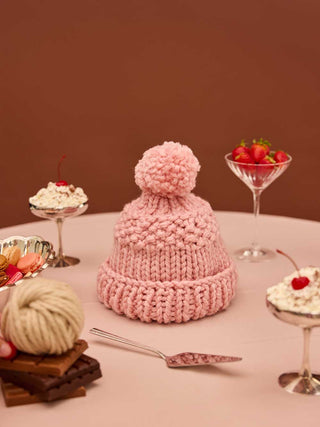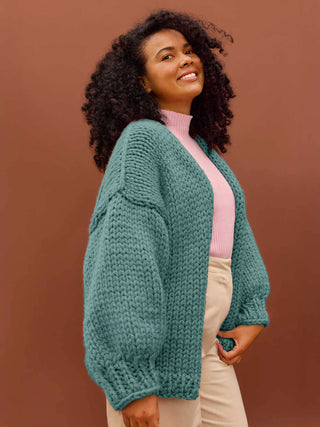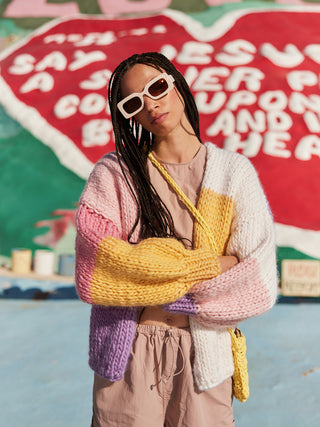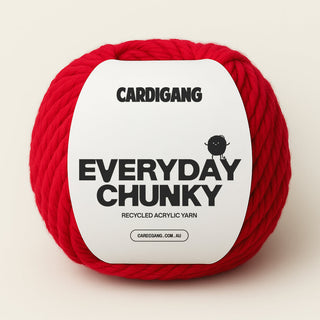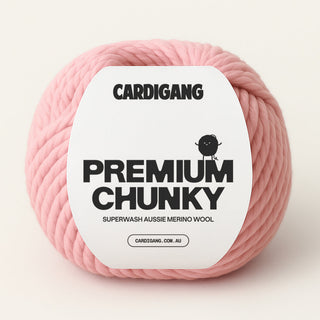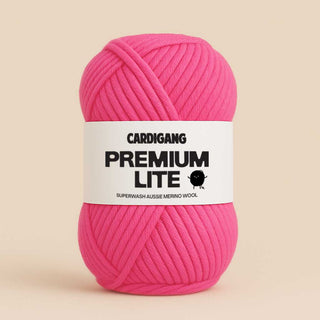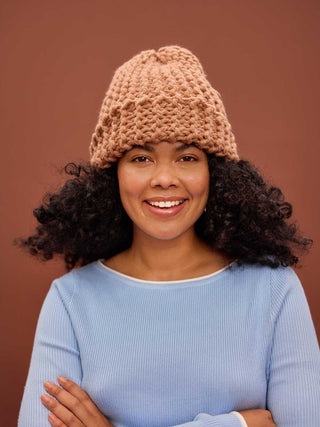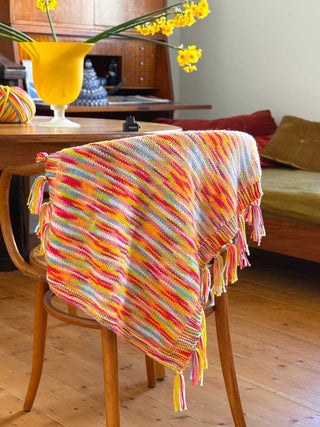A step by step guide to knitting the electric, Elizabeth.
Ever gotten half way through a project and thought “Hang on, am I even doing this right?”
We have 🙋♀️
That’s why we’ve created these step by step overviews to help guide you through the knitting process. At each stage we’ll show you how each section of your piece should look, and at the end, how to sew it all together. Voilà!
THE BASICS
If you're a total knitting newbie - WELCOME! Learning to knit can feel like learning code. We've stripped away the complicated jargon and tried to keep things really simple. 🧶
Before we get started on the pattern it’s a good idea to learn the basic stitches you’ll need to complete your masterpiece. You can use the yarn that came in your kit to practice with. We’ve put the below video together to cover the basics. Learn how to cast on, do a knit stitch, a purl stitch and put them together to create a 1x1 rib stitch, lastly we learn casting off. Once you've got these mastered you'll find this pattern is a cinch!
💭 For more detailed videos of each technique, head down a little further where we've got specific videos for each stitch type. While the Elizabeth is knitted in Mohair (not Merino as shown in the videos) the techniques are exactly the same 🤓 👩🎓
🏅🧶 You got this! ⚡️💪
Remember learning a new skill can be a little hard at first and you’re bound to find yourself making some mistakes along the way. But as with learning anything, your brain and your hands slowly start to get the hang of it, muscle memory is created, and soon the thing you found tricky/daunting/scary is like second nature!
If you get stuck, reach out to us and we'll give you a hand! 😎
TEST YOUR TENSION
It’s a good idea to check that the tension (how tightly or loosely your knitting is) is in line with what we need. We knit a “tension swatch” to make sure the tension is juuuust right. It's a bit like goldilocks, if the tension is too tight, your jumper will be too small, and if it's too loose it may not hold it's shape and might be too big.
If done correctly, your 10x10cm knitted swatch should be 8 stitches high and 11 rows wide when knitted on 12mm needles. To test this, jump on your needles, cast on around 16 stitches, then knit in stockinette stitch (row 1 knit, row 2 purl) for around 12 rows. Then use the card that came in your kit to measure 10x10cm and count your stitches and rows to make sure you're knitting at the correct tension.
CHUNKY MOHAIR
We knit our Chunky Mohair double strand. This means you have two strands on the go at once. To start with, we suggest pulling one tail from one ball and one from another. As you get more confident you can work with one ball if you like, you'll just use both ends of the ball.
💭 🚨 Now, a little word of caution when knitting with two strands. It's a lot easier to put your needle through your stitch in the wrong place when you're knitting with two strands. If you do this you'll end up with more stitches on your needle than you've cast on 🤯 We recommend counting your stitches every few rows as you knit to make sure you haven't added any rogue stitches. If you have, and it's picked up quickly, you can knit two stitches together on the next row to get back to your correct number of stitches for the piece.
Here's what that looks like when you cast on.


ONTO THE ELIZABETH!
SIZING
You can knit the Elizabeth in sizes from 6 to size 24. Your pattern is read like this: 6-8 (10-12, 14-16, 18-20, 22-24).
WHAT YOU’LL NEED
Your kit comes with everything you need to knit your masterpiece. To knit Elizabeth you’ll use;
- 10mm circular needles - we use these for the rib at the bottom, on the cuffs and around the neckline
- 12mm circular needles - these are to knit the body of your jumper
- 5-7 balls colour 1
- 2 balls colour 2 and 3
- Darning needle - this is used to sew your masterpiece together and weave in loose ends
CASTING ON
Casting on is the first step in any project. It's the term we use for getting the wool onto our needles! We recommend using the two-needle technique as it's one of the simplest methods. Two-needle cast on uses your two needles (surprise!), starting with a slip knot on your left needle, each stitch is knitted to form a new loop and this loop is then added to your left needle. You repeat until you’ve made the desired number of stitches.
💭 Casting on, like many things in knitting, can be done in a number of ways - our suggestion is a simple technique but you can pick any that’s right for you.
KNIT STITCH
This handy little stitch makes up the backbone of most knitting patterns. Each knit stitch looks like a little ‘v’.
PURL STITCH
The second most common stitch, purl stitches look like little bumps (or purls!). You knit a knit stitch with your yarn tail at the back of your work and your needle going into the back of the stitch, the purl is the opposite, so your yarn tail is at the front of your work and your needle goes into the front of the stitch.
STOCKINETTE STITCH
Stockinette Stitch (or stocking stitch) is a basic stitch that most knitting patterns often don't explain! When knitting flat, you create stockinette stitch by knitting one row and purling the next. This means all of your knit stitches (the little Vs) will be on the right side of your jumper.
💭 We go into a stockinette stitch once we stop knitting in the round.
RIB STITCH
1x1 rib stitch is a textured pattern usually used on the cuffs and necks of jumpers. It’s made by alternating knit and purl stitches in the same row, then knitting the same stitch sequence in the next row. When doing your rib stitch it’s important to make sure your yarn is on the correct side of your needles (at the back for knit stitches and at the front for purl stitches). To see rib stitch in action watch our "Master The Basics" video above.
KNITTING IN THE ROUND
Knitting in the round is where we use our circular needles and knit continuously in loops, rather than back and forth in rows (like a lot of beginner patterns do). Now don't worry! It's not anywhere near as hard as it sounds. When knitting in the round, you're always knitting on the "front" side of your work so you don't need to turn the piece to knit on the "back" side. Plus, you don't need to sew your pieces together at the end!
REDUCING STITCHES
We reduce stitches in the neckline and the sleeves to give them shape. This is done by knitting or purling some stitches together. This simply means we put our right needle into the second stitch on your left needle and collect both the first and second stitch and knit them as you would a single stitch.
CASTING OFF
To cast off, knit two stitches then slip the first stitch on your right needle back over the second stitch and off the needle. You’ll have one stitch left on your right needle. Knit another stitch so you’ve got two stitches on your right needle and then slip the first stitch off. Continue to the end of the row. When you’ve got the last stitch on your right needle, cut the yarn and thread this through the final stitch to secure. To see casting off in action watch our "Master The Basics" video above.
Let's knit up a storm!

BODY
We start knit the body in the round and from the bottom up. That mean's we'll start with a rib stitch before we move into knit stitch.
Step 1:
Cast on the required number of stitches using your 10mm circular needles and colour 1 yarn.
Step 2:
Once you've cast on the right number of stitches you move on to the rib. Knit the rib following the instructions in your pattern. Remember to create a rib we knit 1 stitch, then purl the next. Make sure you’re moving your yarn tail from the back to the front of our stitch to ensure the stitch is executed correctly.
JOINING YOUR STITCHES
When we knit in the round it’s important to make sure that you connect your stitches in a loop when you knit your first row.
💭 Make sure you use a stitch marker to keep track of the number of rows/loops you’ve knitted. A stitch marker can be anything round; a ring, hair tie or a spare piece of yarn.
Step 3:
Next, we move onto using our 12mm circular needles and into knit stitch.
To switch to a different size needle we just hold the new needle (in this case the 12mm circular needle) in our right hand and knit onto the stitch on your 10mm needle in your left hand. Simple!
We knit the required number of rows in colour 1 before we change to colour 2.
Step 4:
Next we're going to change our yarn colour to colour 2. We always change colours at the end of a row. Watch the video below to see how.
We’ll work the allocated rows of knit stitch in colour 2.
Step 5 - 9:
We'll work through colour 3, back to colour 2 and then into colour 1 again. We do every colour change in exactly the same way as the first time.

Step 10:
We're going to split the work now, so we knit up the back and the front of the body separately. Knit the allocated number of stitches.
Step 11:
Flip your work over and we're going to work these stitches again. The other stitches will just hang out on your needle until we're ready to come back to them. Purl your stitches.
Step 12 - 16:
Continue knitting in stockinette stitch and changing colours as instructed.
Step 17:
Cast off the stitches you've been working. That's the back part of your body done! Well done 💪

Step 18:
Attach your yarn to the first of the stitches you've got left on your needle. You'll want to pick the side that means you'll start with a knit stitch - so the 'v's should be on the side facing you.

Step 19 - 23:
Continue to knit up the front panel in the same way you did the back.
⚡️ 💭 Okay, so we're now going to shape the neckline and to do this, we split the work into two shoulders and a space for the head hole. Skip down to watch a video that shows you how to knit the neckline from start to finish.
Step 24 - 29:
We work the neckline over 6 rows. First, knit the allocated number of stitches and then knit two stitches together. Flip your work and purl those stitches. Then repeat.
Step 30:
Cast off those stitches. Shoulder 1 done!
Step 31:
Rejoin your yarn by tying a knot to the base of the stitch closest to the tip of your needle. We're going to cast off some stitches to create that gap for the head-hole.
Once you've cast off the allocated number of stitches, you'll have one stitch left on your right needle. Just slip that one back onto your left needle and we will knit two stitches together before we knit the rest of the stitches.
Step 32 - 37:
We continue in the same way we did for the first shoulder.
Cast off the stitches for shoulder 2 and that's the body done 🚀
SEW YOUR SHOULDERS
Before we move into the sleeves we're going to sew the shoulders of your body up. Grab your darning needle to sew the shoulder seams together using the invisible seam technique - demonstrated in the video below.
SLEEVES
Onto the sleeves. You'll do two of theses too 😎🧶
We start at the top of the sleeve and knit down to the rib.
Step 1:
Using your 12mm needles and colour 1, we'll pick up the allocated number of stitches from around the arm hole. The below video demonstrated this technique on a neckline but the process for the arm holes is the same.
Step 2 - 7:
We're knitting in the round again which means we knit every row. This should be a cinch by now! 💪 Knit and follow the instructions to change colours.
Step 8:
To get the shape in our sleeve, we're going to decrease some stitches before we knit the cuff. You'll knit two stitches together all the way along the row.
Step 9:
Once that’s done you'll swap to your 10mm needles to start your rib stitch for the allocated number of rows.
Step 10:
Cast off your stitches. When you cast off make sure it’s not too tight otherwise you’ll have a really tight wrist hole!
NECKLINE
We're SO CLOSE! I can see the finish line 🎢🙌
We knit the neck in the round with colour 1 and our 10mm needles.
So first things first. We pick up the allocated number of stitches in equal distance from around the neck hole. Once you’ve got all your stitches on your needles you join the loop together and start the rib stitch.
Knit in the round until you’ve completed 4 loops then cast off.
💡 Now this part is critical! Cast of extra loosely!! You need a loose cast off in order to be able to fit your head through the hole. Rib stitch has a stretch to it, but if you cast off too tightly you'll have a hole that's too small for your head to fit through. Been there, done that and DON'T recommend 😝
The last thing we do for every piece is weave in the ends. That’s basically just tidying up the piece so all loose ends are trimmed down and tucked in.
We'd LOVE to see how you go! Share your masterpiece with us by tagging @cardigang_knits on Instagram or by sending us an email at hello@cardigang.com.au
Until next time! 😘🧶💕
Morgan & Cat xx


